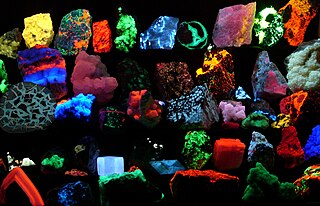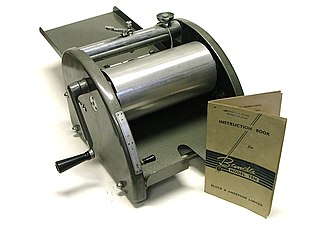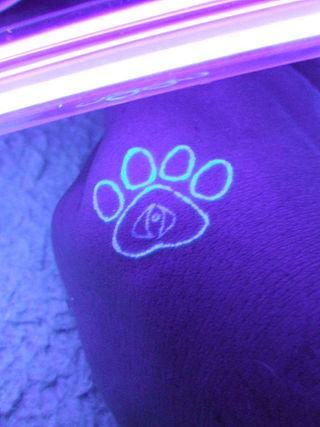
A blacklight poster or black light poster is a poster printed with inks which fluoresce under a blacklight. [1] The inks used contain phosphors which cause them to glow when exposed to ultraviolet light emitted from blacklights. [2] [3]

A blacklight poster or black light poster is a poster printed with inks which fluoresce under a blacklight. [1] The inks used contain phosphors which cause them to glow when exposed to ultraviolet light emitted from blacklights. [2] [3]

Although blacklights date to 1903 with the development of the optical filter glass Wood's glass, fluorescent ink was not developed until 1932 when the Switzer brothers were inspired by a Popular Science magazine article to experiment in their father's pharmacy. Their Day-Glo Color Corp. marketed the ink chiefly to the military before a counterculture emerged to embrace the aesthetic. [4] The 1960s saw the pervasive use of recreational drugs, especially mass use of hallucinogenics such as LSD (lysergic acid diethylamide), mescaline, and marijuana for the first time. [5] With the ability to glow and vibrate under ultraviolet light, the posters could simulate the sensations and visual distortions one experiences during an acid trip. [6]
In the United States, blacklight posters emerged as part of the psychedelic fashion scene between 1967 and 1969. [7] The style was popular in advertisements for concerts at venues like the Fillmore and Avalon Ballroom, and further promoted and commercialized by companies like Pandora Productions (established in Minneapolis, 1964) and the Houston Black Light Company (Houston, 1969). Designs ranged from respectful copies of concert posters to prurient adolescent fantasies. At its height radical black artists found inspiration in the aesthetic, such as Faith Ringgold's series of Black Light paintings that eschewed any white pigment, or Barbara Jones-Hogu's prints (especially Relate to Your Heritage). Commercial producers happily reciprocated by incorporating blaxploitation themes into their posters, as in George Goode's series for the Houston Black Light Company and George Stowe Jr.'s work for One Stop Posters. [4]
Since then, the art form has gone out of fashion and is generally viewed as a relic of the 1970s. [8]
Although blacklight posters have continually been produced since the 1960s, there has been a resurgence in popularity since 2007 as blacklight and glow-in-the-dark parties have become more popular[ citation needed ]. As of 2014, there are five companies actively producing new and classic flocked blacklight posters in a wide range of content, including music, nature, and pop culture. The black parts of these posters are overlaid with black flocking, which gives them a velvet feel, and these are often referred to as velvet posters.
Artists continue to make use of the material, notably Dorothy Cross's 1998 Ghost Ship (a decommissioned light ship painted to glow at night, evoking the pigment's original military purposes), or Hank Willis Thomas's 2014 screenprints And I Can't Run and Blow the Man Down (exposing black victims under fluorescent light, evoking the pigment's historic association with black radicalism). [4]

Fluorescence is the emission of light by a substance that has absorbed light or other electromagnetic radiation. It is a form of luminescence. In most cases, the emitted light has a longer wavelength, and therefore a lower photon energy, than the absorbed radiation. A perceptible example of fluorescence occurs when the absorbed radiation is in the ultraviolet region of the electromagnetic spectrum, while the emitted light is in the visible region; this gives the fluorescent substance a distinct color that can only be seen when the substance has been exposed to UV light. Fluorescent materials cease to glow nearly immediately when the radiation source stops, unlike phosphorescent materials, which continue to emit light for some time after.

Ultraviolet (UV) light is electromagnetic radiation in a range of energies higher than that of visible light, but less than X-rays. UV radiation is present in sunlight, and constitutes about 10% of the total electromagnetic radiation output from the Sun. It is also produced by electric arcs; Cherenkov radiation; and specialized lights, such as mercury-vapor lamps, tanning lamps, and black lights.

Screen printing is a printing technique where a mesh is used to transfer ink onto a substrate, except in areas made impermeable to the ink by a blocking stencil. A blade or squeegee is moved across the screen to fill the open mesh apertures with ink, and a reverse stroke then causes the screen to touch the substrate momentarily along a line of contact. This causes the ink to wet the substrate and be pulled out of the mesh apertures as the screen springs back after the blade has passed. One colour is printed at a time, so several screens can be used to produce a multi-coloured image or design.
Magenta is a purplish-red color. On color wheels of the RGB (additive) and CMY (subtractive) color models, it is located precisely midway between red and blue. It is one of the four colors of ink used in color printing by an inkjet printer, along with yellow, cyan, and black to make all the other colors. The tone of magenta used in printing, printer's magenta, is redder than the magenta of the RGB (additive) model, the former being closer to rose.

Invisible ink, also known as security ink or sympathetic ink, is a substance used for writing, which is invisible either on application or soon thereafter, and can later be made visible by some means, such as heat or ultraviolet light. Invisible ink is one form of steganography.

A fluorescent lamp, or fluorescent tube, is a low-pressure mercury-vapor gas-discharge lamp that uses fluorescence to produce visible light. An electric current in the gas excites mercury vapor, which produces short-wave ultraviolet light that then causes a phosphor coating on the inside of the lamp to glow. A fluorescent lamp converts electrical energy into useful light much more efficiently than an incandescent lamp. The typical luminous efficacy of fluorescent lighting systems is 50–100 lumens per watt, several times the efficacy of incandescent bulbs with comparable light output. For comparison, the luminous efficacy of an incandescent bulb may only be 16 lumens per watt.

A T-shirt is a style of fabric shirt named after the T shape of its body and sleeves. Traditionally, it has short sleeves and a round neckline, known as a crew neck, which lacks a collar. T-shirts are generally made of stretchy, light, and inexpensive fabric and are easy to clean. The T-shirt evolved from undergarments used in the 19th century and, in the mid-20th century, transitioned from undergarments to general-use casual clothing.

A spirit duplicator is a printing method invented in 1923 by Wilhelm Ritzerfeld that was commonly used for much of the rest of the 20th century. The term "spirit duplicator" refers to the alcohols that were a major component of the solvents used in these machines.

Phosphorescence is a type of photoluminescence related to fluorescence. When exposed to light (radiation) of a shorter wavelength, a phosphorescent substance will glow, absorbing the light and reemitting it at a longer wavelength. Unlike fluorescence, a phosphorescent material does not immediately reemit the radiation it absorbs. Instead, a phosphorescent material absorbs some of the radiation energy and reemits it for a much longer time after the radiation source is removed.

A blacklight, also called a UV-A light, Wood's lamp, or ultraviolet light, is a lamp that emits long-wave (UV-A) ultraviolet light and very little visible light. One type of lamp has a violet filter material, either on the bulb or in a separate glass filter in the lamp housing, which blocks most visible light and allows through UV, so the lamp has a dim violet glow when operating. Blacklight lamps which have this filter have a lighting industry designation that includes the letters "BLB". This stands for "blacklight blue". A second type of lamp produces ultraviolet but does not have the filter material, so it produces more visible light and has a blue color when operating. These tubes are made for use in "bug zapper" insect traps, and are identified by the industry designation "BL". This stands for "blacklight".

Black light paint or black light fluorescent paint is luminous paint that glows under a black light. It is based on pigments that respond to light in the ultraviolet segment of the electromagnetic spectrum. The paint may or may not be colorful under ordinary light. Black light paint should not be confused with phosphorescent (glow-in-the-dark) or daylight fluorescent paint.
A highlighter, also called a fluorescent pen is a type of writing device used to bring attention to sections of text by marking them with a vivid, translucent colour. A typical highlighter is fluorescent yellow, with the color coming from pyranine. Different compounds, such as rhodamines are used for other colours.
Luminous paint is paint that emits visible light through fluorescence, phosphorescence, or radioluminescence.

Gum printing is a way of making photographic reproductions without the use of silver halides. The process uses salts of dichromate in common with a number of other related processes such as sun printing.

UV tattoos or blacklight tattoos are tattoos made with dyes that fluoresce visibly under a blacklight or other ultraviolet (UV) light source. Depending upon the tattoo ink used, an ultraviolet tattoo can be nearly invisible when illuminated only by light within the visible spectrum. Blacklight tattoo ink does not glow in the dark, but reacts to non-visible ultraviolet light, producing a visible glow by fluorescence.
Reverse bluescreen is a visual effects technique pioneered by Jonathan Erland of Apogee Inc.(John Dykstra's company) for shooting the flying sequences in the film Firefox. Its objective is to enable the matting of subjects that confound the conventional process, such as those exhibiting reflective surfaces. It derives its name from the fact that it reverses, or inverts, the basic bluescreen process. Erland received a Scientific and Engineering Award from the Academy of Motion Picture Arts and Sciences for this technique.

An ultraviolet (UV) marker is a pen whose marks are fluorescent but transparent; the marks can be seen only under an ultraviolet light. They are commonly used in security situations to identify belongings or to prevent the reproduction of unauthorized banknotes. UV pens can now be bought at some stationery shops to securely mark items of high value in case of theft.

Tagging of postage stamps means that the stamps are printed on luminescent paper or with luminescent ink to facilitate automated mail processing. Both fluorescence and phosphorescence are used. The same stamp may have been printed with and without these luminescent features, the two varieties are referred to as tagged and untagged, respectively.

The Day-Glo Color Corp. is a privately held American paint and pigments manufacturer based in Cleveland, Ohio. It was founded in 1946 by brothers Joseph and Robert Switzer and is currently owned by RPM International. It specializes in fluorescent paint and pigments, such as those used in safety applications, artwork and signage. It invented black-light fluorescent and daylight fluorescent paints and nondestructive testing methods using fluorescent dyes.

The conservation and restoration of paintings is carried out by professional painting conservators. Paintings cover a wide range of various mediums, materials, and their supports. Painting types include fine art to decorative and functional objects spanning from acrylics, frescoes, and oil paint on various surfaces, egg tempera on panels and canvas, lacquer painting, water color and more. Knowing the materials of any given painting and its support allows for the proper restoration and conservation practices. All components of a painting will react to its environment differently, and impact the artwork as a whole. These material components along with collections care will determine the longevity of a painting. The first steps to conservation and restoration is preventive conservation followed by active restoration with the artist's intent in mind.